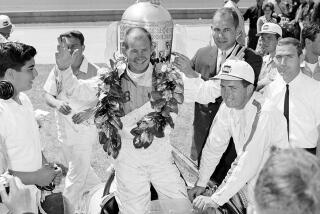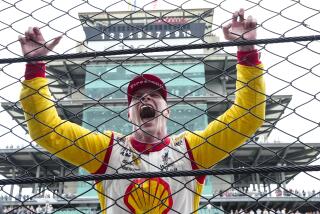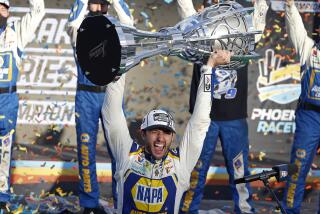A Young Man’s Business : Indianapolis 500: Although most of the drivers are older than he is, Tony George, at 30, has inherited a long family history in racing.
- Share via
INDIANAPOLIS — The drivers might be getting older in the Indianapolis 500, but management is getting younger.
Tony George, grandson of the late Tony Hulman, who saved the Indianapolis Motor Speedway when he bought it in 1945, is the new president of the speedway and, at 30, is younger than all but five of the 33 starters in Sunday’s 74th Indianapolis 500.
George took over the family-owned Hulman raceway empire in January, shortly after the death of 81-year-old Joe Cloutier in November. Cloutier, a longtime employee of Hulman, was appointed president after Hulman’s death in 1977.
Anton Hulman George, named for his grandfather, also brings a racer’s viewpoint to the speedway.
George didn’t take up the family sport until he was 24, but raced with a measure of success for five years before being forced to quit this year because of the pressures of his new position.
“At first, I went to some driving schools so I could get a better feel for the technical side of the sport, because I knew it was sort of expected that I would take over someday,” George said in his offices in the speedway museum. “I don’t pretend to relate to the way the drivers in the 500 feel, but I think it did help me to understand them better.”
George, who drove one of A.J. Foyt’s cars last year in the American Racing Series--the triple-A farm series for prospective Indy car drivers--also has worked on Foyt’s pit crew during Indy car races for the last two seasons. He will not be manning the fuel hose Sunday because of his duties as speedway president, but he hopes to be with the team for the rest of the CART season.
“I can’t take the time to race myself, because racing is too much of a full-time occupation if you want to be successful, but I enjoy working on race day with A.J.’s crew.” he said. “I got to know them real well last year when they worked on my ARS car.”
Foyt, who will be driving in his 33rd consecutive 500, was a close friend of George’s father, Elmer George, who was killed in a shooting the night of the 1976 Indianapolis 500. Foyt and Elmer George raced together in sprint cars and Indy cars.
Elmer George drove in three Indy 500s, the most memorable being his rookie year in 1957 when he ran into the rear of Eddie Russo’s car during the parade lap and knocked both of them out of the race before it started.
Later that year, George won his only U.S. Auto Club Indy car race, the Syracuse 100, and finished 10th in the USAC standings.
Elmer George also drove in the 1962 and 1963 races. His highest finish was 17th.
“I don’t remember my dad as a racer,” Tony George said. “I’ve heard a lot of stories from A.J. about racing with him, and people tell me that I went to races when I was little--but I don’t remember it.”
Although his home was in Terre Haute, Ind., Tony spent much of his youth on the family ranch in Cora, Wyo., where he rode horses and baled hay instead of racing cars or minibikes the way his sons, ages 6 and 9, are doing today.
Tony was 24, married and living in Indianapolis when a friend talked him into enrolling at Skip Barber’s driving school. He enjoyed the sensation of speed enough to buy a Formula Ford and go racing.
“My biggest thrill was at Elkhart Lake (Wis.) when I won my first race,” George said. “It was in a Formula Ford built by Steve Krisiloff (George’s brother-in-law and a former Indy car driver) and I was fast qualifier, sat on the pole and came from behind to win by about six inches right at the finish line.
“I had been running second and third in earlier races and getting my first win will always be special. I had a couple of other wins that year. I think 1985 was the most enjoyable year I ever had.”
George moved up to Super Vees for two years and then, in 1989, joined Foyt’s team as an ARS driver.
“I feel like Tony’s one of my own children because I’ve known him since he was born,” Foyt said. “I told him if he ever really wanted to be serious about racing, I’d give him all the help I possibly could.”
Neither Foyt nor George had a very good year, however.
“A.J. couldn’t get his own car working right, so it was hard for the crew to concentrate on mine,” George said. “We ran our races on the same program with the Indy cars and that made it tough for me. A.J. only finished two races after he ran fifth here. I worked on the crew for the 500. That was the high point of the year.
“I’d like to go racing again myself, but right now it’s up to me to learn as much about running the track as I can. Then I’ve got all the other Hulman duties to worry about, too.”
George, a business graduate of Indiana State, is executive director of Hulman & Co., which is involved in commercial real estate, shopping centers, two television stations in Florida, a TV production company and other business enterprises. But the speedway is his primary interest.
“If I’ve had any impact, or influence, on the speedway, it’s in its operation. When Joe (Cloutier) was in charge, he’d drive over from Terre Haute (about 80 miles) when he felt like it, maybe a couple of times a month, and department heads would line up hoping to catch him before he took off and went back to Terre Haute.
“I live in Indianapolis and we have regularly scheduled staff meetings so everyone knows what is going on and what we need to do. All of the people who were around my grandfather for so many years, like Joe and Clarence Cagle, who was superintendent for so long, have left, but they left with very good people in charge to carry on.”
George’s first job at the speedway, however, was not at the race track but at the adjacent golf course, which, like the Speedway Motel, where past winners stay, is part of the family’s racing package.
“I worked as a cart boy when I was 15. It wasn’t until I was nearly 19 that I began to realize I was going to take over some day and started spending some time with Charlie Thompson (speedway superintendent). Mostly I just followed him around, getting to know the gates and tunnels.
“Maybe the first time it hit me how much the speedway meant to me was the first time I heard my grandmother announce, ‘Gentlemen, start your engines.’ I got goose bumps and chills ran up and down my back.
“The last two years Joe was alive, I got serious and began to take part in the executive decisions, things like contract negotiations, broadcast rights, pace car selection, things like that. I felt I was ready to take over when Joe died, but it made me feel good to know the family had enough confidence in me to have me assume the presidency.
“This is a family-owned business and there’s one big advantage to that: There’s only one shareholder to make happy.”
More to Read
Go beyond the scoreboard
Get the latest on L.A.'s teams in the daily Sports Report newsletter.
You may occasionally receive promotional content from the Los Angeles Times.










